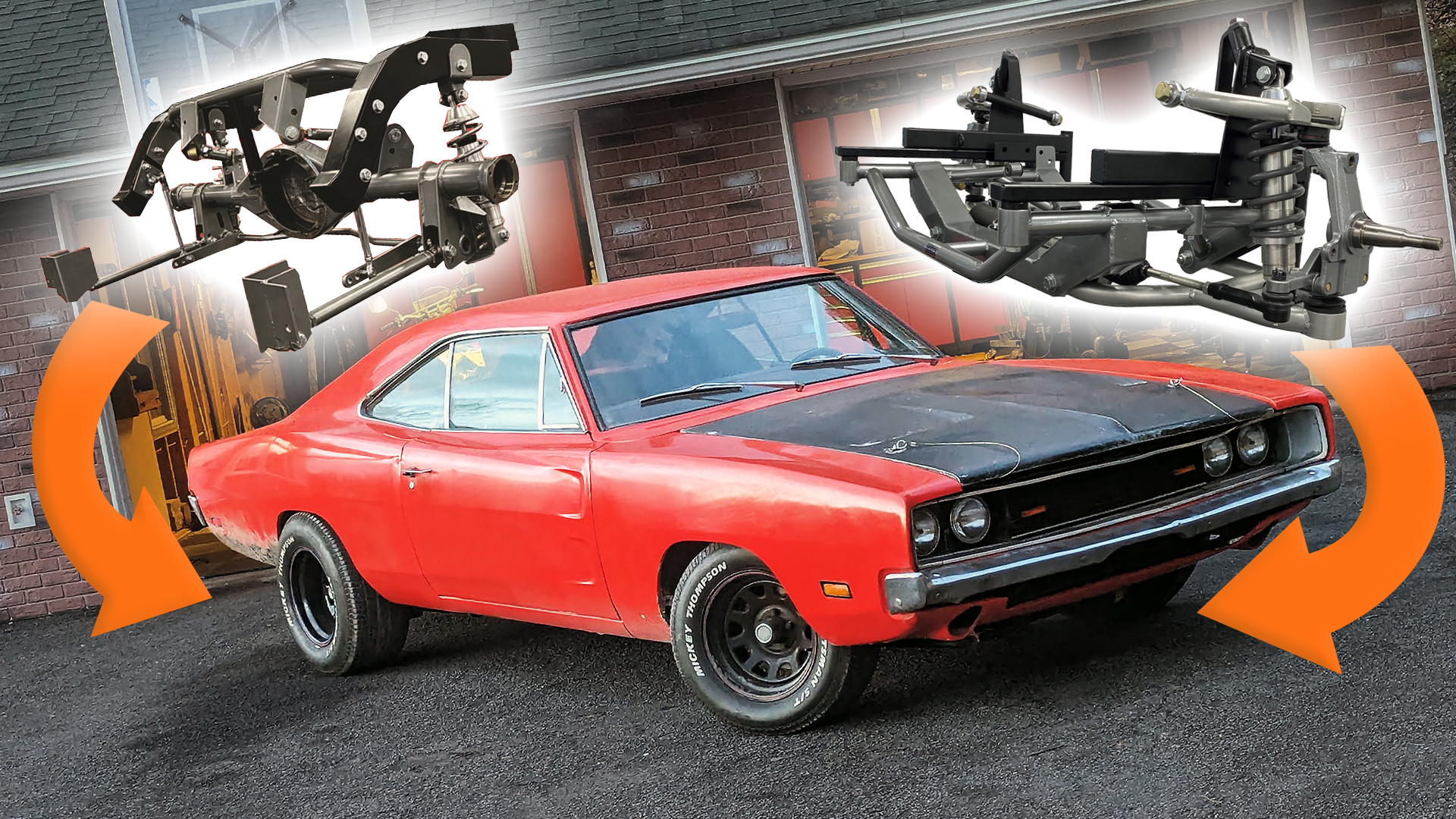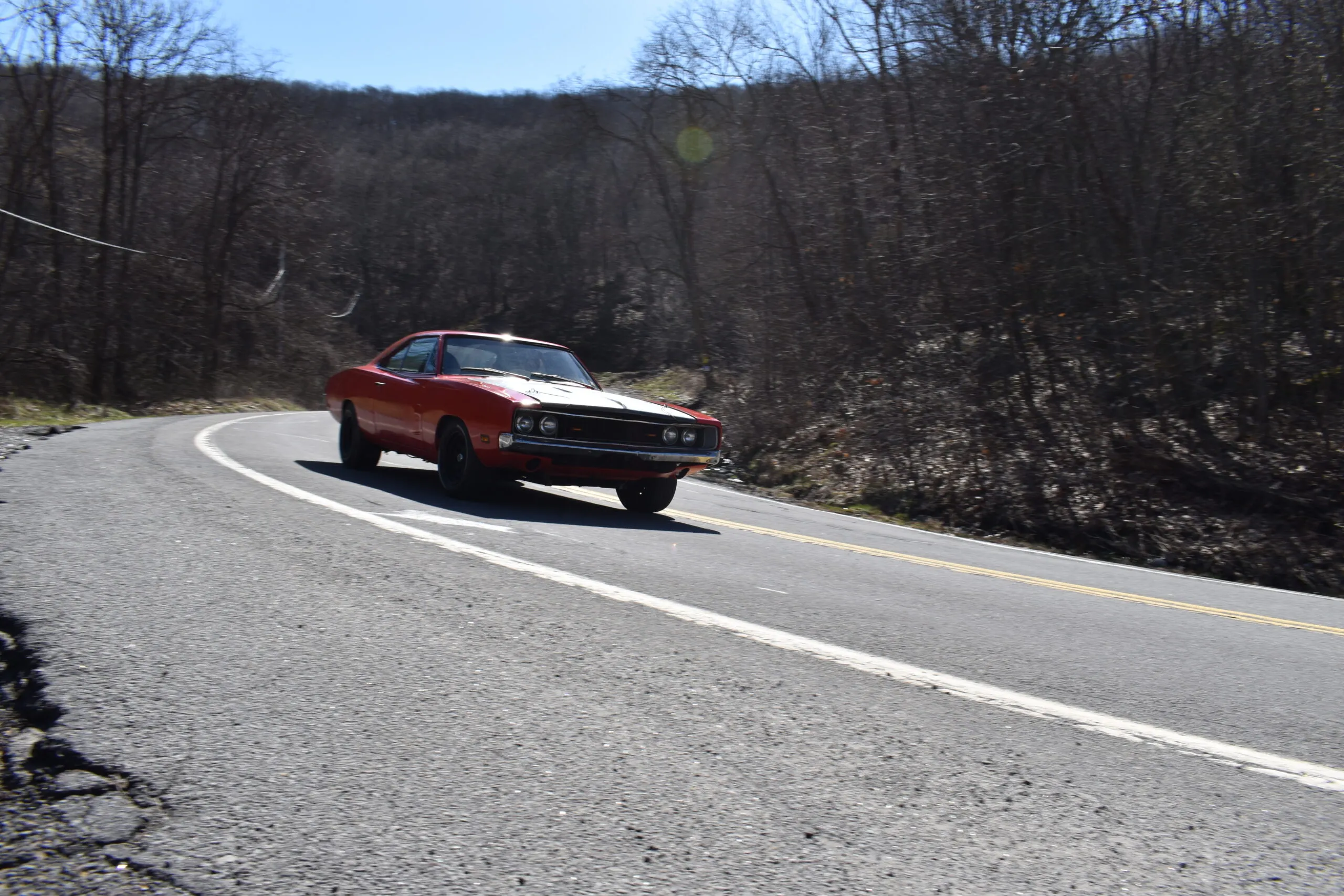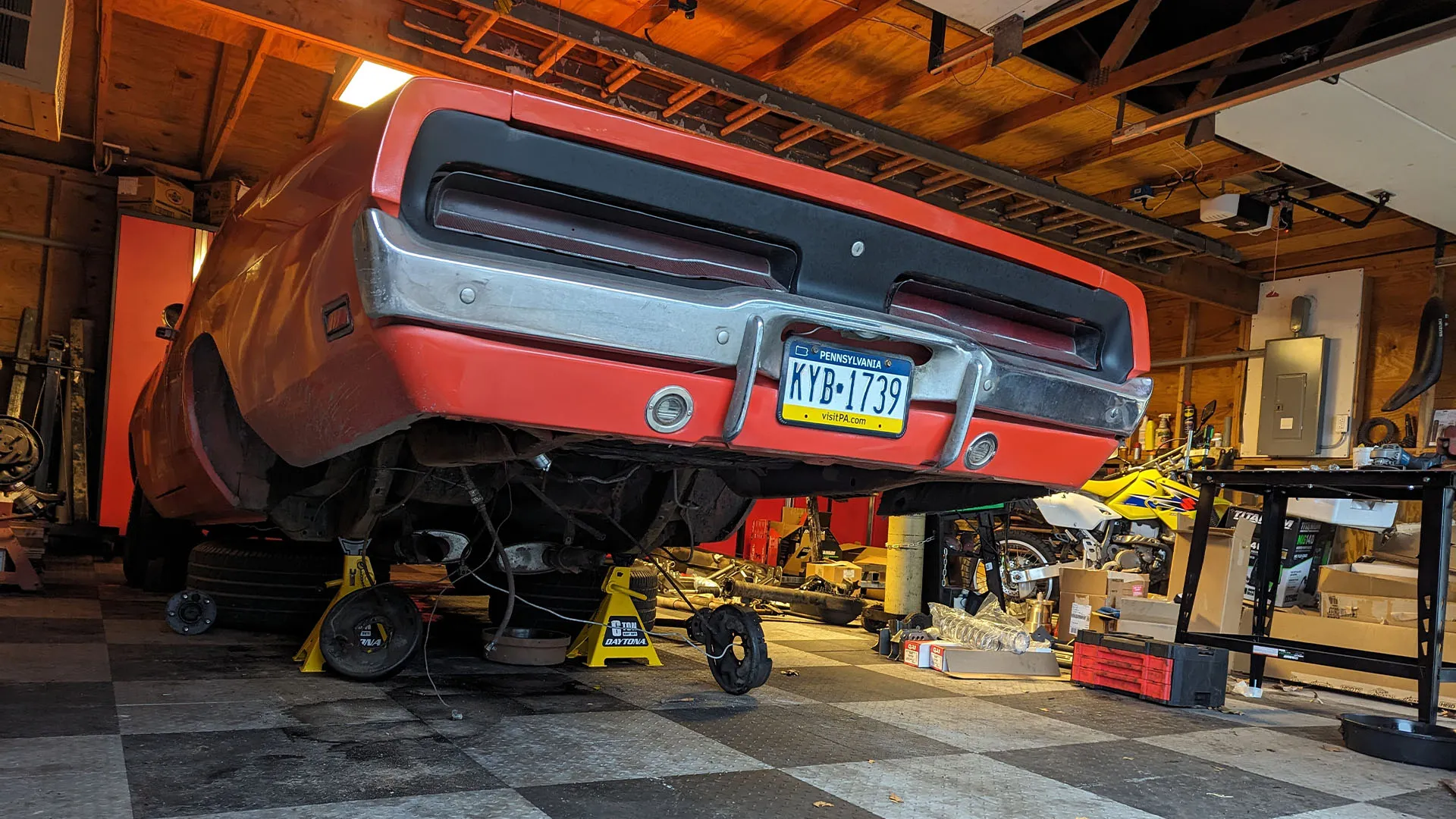

We may earn revenue from the products available on this page and participate in affiliate programs. Learn more ›
One of the few beauties of being alive in 2024 is it’s easier than ever to achieve the dream of a classic muscle car with modern performance. Aftermarket companies are slinging all manner of bolt-on EFI conversions, overdrive swaps, disc brake kits, and engine mounting solutions to help you bring vintage iron to the 21st century.
Note that I said easier than ever. Things aren’t as simple when we’re talking about steering and suspension upgrades, where a new part like a steering box or control arms might yield some improvements, but true transformation is still held back by the dated engineering around it. Swapping to a different configuration altogether that will actually make it drive like a new car takes a lot more effort, fabrication skills, and money.

Heidts Hot Rod and Muscle Car Parts is among the few aftermarket companies that are working to change that tune, producing complete suspension conversions for old Fords, Chevys, and Mopars that make dramatic improvements over what rolled off the assembly line back in the day. The systems they offer are the likes of what you would usually work up with custom builders—except it’s a bolt-in kit sent to your door under a single part number, and you install it yourself on your car. But can it really be that simple?
That’s what I’m here to find out with my 1969 Dodge Charger project. Over the coming weeks, I’ll be installing and testing Heidts’ Pro-G bolt-in independent front suspension and bolt-in 4-link rear suspension kits on my pride and joy. This isn’t gonna be your average product review. My goal is to take you through the full experience of installing them on my car from start to finish to give a deeper look at what this kind of intensive DIY upgrade entails, how realistic it is for the average owner to attempt—and how it actually changes the car’s handling in the end.
Who Is Heidts, and What Am I Getting Myself Into?
Heidts Hot Rod and Muscle Car Parts has been around for over 30 years. Over the years, it’s been honing its edge in producing kits that balance massive improvements while keeping things as simple as possible on the installer end of things.
Now, that doesn’t mean these kits are built for novices, despite the “bolt-in” label. Their inherently intense nature still requires advanced skills to be set up properly. However, all the really hardcore stuff like blueprinting the layout and building brackets and cross members has been done for you.
The Pro-G front end is a pretty heavy duty upgrade for my car. The astute among you already know that the 1969 Dodge Charger has an independent front suspension as is, but this kit aims to make some major improvements in a few key areas—most notable is the move from torsion bars to adjustable coilovers. This change simplifies packaging and stacks with the move to an adjustable double-wishbone setup over the factory configuration that uses a strut rod to locate the lower control arm. On top of that, it moves engine rearward for improved balancing. It also converts the car to work with rack and pinion power steering, with everything bolting neatly into a custom K-member.

The 4-link rear conversion is as the name implies. It converts the axle-on-leaf system to a triangulated 4-link system with coilovers. These setups do a much better job of keeping the axle centered under load and in turns, which should improve handling and ride quality and eliminate issues with wheel hop. Stacked with the new IFS system, it promises to bring my Charger’s ride into the 21st century.
Heidts does offer an independent rear suspension conversion for the Charger. However, it uses a Ford 9-inch and I feel it sits a little too low to the ground for this particular build. There are a lot of dirt roads near my house in Pennsylvania, and impacts with rocks and potholes has already proven to be an issue for me. Besides, I did just set up a really nice 8.75 carrier that I don’t want to get rid of any time soon.
Here’s the Plan
These kits are far from cheap. We’re talking about $6,721 for the front and $2,125 for the rear, and that’s before you factor in any labor costs and additional materials needed to get the work done. Still, they are significantly cheaper than what you’d spend on a custom build, and that’s potentially a game-changer for a lot of classic car owners.
Now, I want to disclose that I received these kits for free for the purposes of writing this series. That might set off your BS detector, but as The Drive does for any product we review, I made it clear to Heidts that I’m gonna call it like I see it. And if anything, I have a bias towards keeping the factory configuration in my car. To Heidts’ credit, they wouldn’t have it any other way.
While this is a dream opportunity for a hot-rodder, my ultimate goal here is to give you the insight you need to gauge what these systems bring to the table in every regard. I want anyone who’s considering these types of systems to walk away with an intimate understanding as to whether Heidts offers the solution they need, or whether they’d be walking into an absolute mess.
Right now, my plan is to have three more stories after this: installing the four-link rear, installing the IFS, and an overall handling evaluation once it’s all buttoned up. The installation pieces will cover how easy (or difficult) the job really is and any issues that pop up. The road test will also break down the effects of either upgrade as a standalone project if you’d rather not tear into both ends of your car. Lastly, I’m keeping an eye on the weight and balance. According to the scale at my local scrapyard, right now the Charger weighs 3,470 pounds with a quarter tank of gas. We’ll see where it ends up.
The Purist in Me Is Still Reluctant
I mean it when I say that I’m biased toward the factory configuration of the Charger. It’s not just the deluded purist in me talking; I truly believe that ’69 Charger has a really good suspension setup that can be significantly improved through smaller tweaks. For example, the leaf springs in the rear use an A-symmetrical spring, where the axle is mounted forward of center. This helps prevent axle wrap issues that most leaf-sprung vehicles suffer from and 4-link kits, including this one, really harp on eliminating.

Axle wrap occurs under heavy load when the portion of the spring ahead of the axle bends into an S-shape, which creates a problem with wheel hop. While classic Mopars aren’t totally impervious to that condition, an old-school trick is to take the rear leaf pack clamps off so the springs can splay out, which helps counteract the problem. There are plenty of examples of drag cars running deep into single digits utilizing this trick for good launches. So, just because the 4-link will truly eliminate this problem, as the marketing materials prominently say, doesn’t automatically make it worth it.
On the front end of the Charger, we have torsion bars supporting the car with a recirculating ball steering system. Torsion bars already offer the ride-height adjustability the IFS conversion brings to the table. The floaty stock steering is a little harder to love [Editor’s note: Hank actually called it “frightening” — KC] but there are some tricks to make it work way better than it does off the assembly line. What I’ve already done to my car is reduced the pressure put out by the power steering pump with the “pump down” mod, swapped to an aftermarket box with a better ratio, and added extended steering arms, like those found on TA cars, to really dial things in and boost road feel.
It’s not perfect, but those upgrades paired with QA1 tubular upper and lower control arms with front and rear sway bars make for a package that does really well cutting through windy Pennsylvania backroads. I can tell you from experience there’s a major difference between it and a totally stock second-gen Charger. Bottom line: the Heidts kits have a lot to prove to me.
I Still Expect Improvements
Still, the cold, hard truth is that there’s a lot of room for improvement over a 55-year-old design. I do foresee some serious improvements in handling, ride quality, and just all around enjoyment of the car. As counterintuitive as it may seem to mention safety when you’re driving a car with lap belts and no airbags, I’ll be frank, there are moments where the Charger is downright scary to drive. There’s a ton of play in the steering and it gets scary light at speeds north of 70 mph. I have high hopes of the front IFS system putting those woes to rest, especially with moving to rack and pinion steering.

If you’ve been reading my Charger updates for a while, you’ll remember that I ran into an issue where I snapped a tubular K-member. I’ve grown to accept it as being a result of my being abusive of the car in situations it wasn’t intended to handle. I don’t have fears of that happening again since this unit is a lot beefier than the last and looks to tuck much more neatly up under the belly of the car.
I’m still a bit skeptical of the 4-link. It’s not that I doubt it; I’m just not entirely sure what to expect. It is a triangulated 4-link and should, in theory, offer far better ride quality and handling than a leaf-sprung system. That said, adjustable coilovers add a layer of control I’ve wanted for some time.

Let’s Get To Work
Yeah. This has been a really long way for me to say it’s time for me to put my money where my mouth is and see what a massive suspension overhaul is all about. It’s a ton of work, and, truth be told, I’m really excited to see what comes of it.
I’d better get to it. I’ve got a ton of grinding, welding, and testing to get to. Stay tuned for the first progress report, and wish me luck.
Got a tip? Send us a note: tips@thedrive.com
